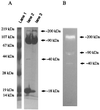Crystal structure of an intracellular protease from Pyrococcus horikoshii at 2-A resolution
- PMID: 11114201
- PMCID: PMC18874
- DOI: 10.1073/pnas.260503597
Crystal structure of an intracellular protease from Pyrococcus horikoshii at 2-A resolution
Abstract
The intracellular protease from Pyrococcus horikoshii (PH1704) and PfpI from Pyrococcus furiosus are members of a class of intracellular proteases that have no sequence homology to any other known protease family. We report the crystal structure of PH1704 at 2.0-A resolution. The protease is tentatively identified as a cysteine protease based on the presence of cysteine (residue 100) in a nucleophile elbow motif. In the crystal, PH1704 forms a hexameric ring structure, and the active sites are formed at the interfaces between three pairs of monomers.
Figures




References
-
- Zeng G. BioTechniques. 1998;25:206–208. - PubMed
Publication types
MeSH terms
Substances
Associated data
- Actions
LinkOut - more resources
Full Text Sources
Other Literature Sources
Molecular Biology Databases
Research Materials

